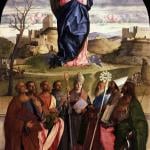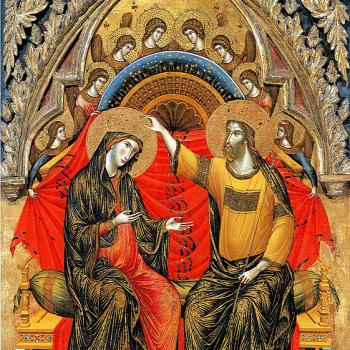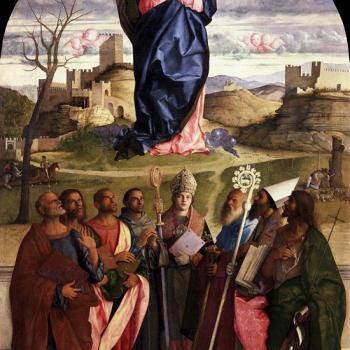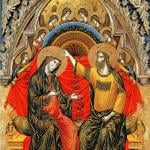Including: Early Protestant Proponents; The Surprisingly Multi-Faceted Biblical Case
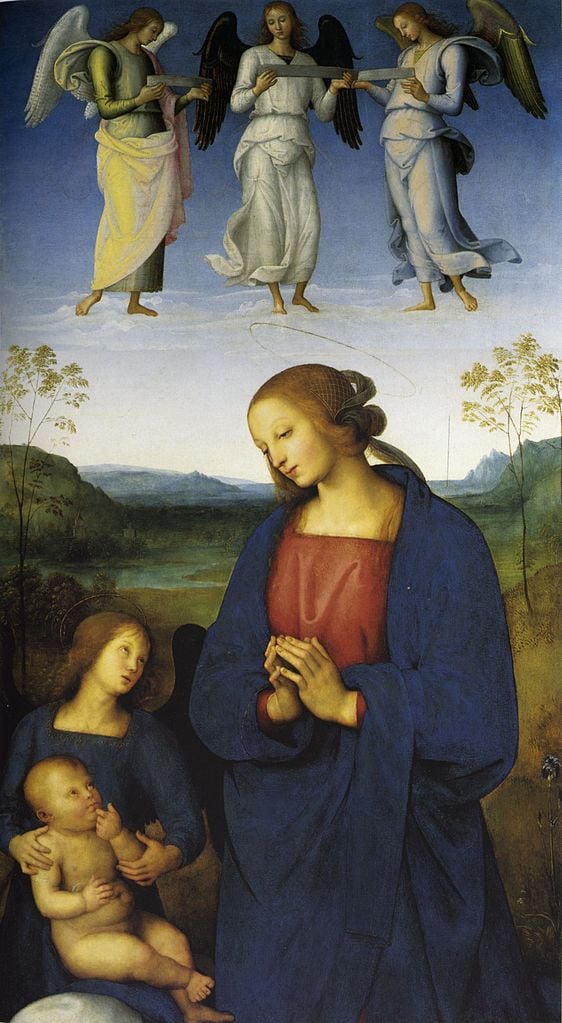
Norman L. Geisler (1932 – 2019) was an American evangelical Protestant theologian, philosopher, and apologist. He obtained an M.A. in theology from Wheaton College and a Ph.D. in philosophy from Loyola University, and made scholarly contributions to the subjects of classical Christian apologetics, systematic theology, philosophy of religion, Calvinism, Catholicism, biblical inerrancy, Bible difficulties, biblical miracles, the resurrection of Jesus, ethics, and other topics. He wrote or edited more 90 books and hundreds of articles.
Dr. Geisler was the Chairman of Philosophy of Religion at Trinity Evangelical Divinity School (1970–79) and Professor of Systematic Theology at Dallas Theological Seminary (1979–88) and a key figure in founding the Evangelical Philosophical Society. He also co-founded Southern Evangelical Seminary. He was known as an evangelical Thomist and considered himself a “moderate Calvinist”. He was not an anti-Catholic (i.e., he didn’t deny that Catholicism was fully a species of Christianity).
This is one of a series of comprehensive replies to his book, Roman Catholics and Evangelicals: Agreements and Differences (co-author, Ralph E. MacKenzie, graduate of Bethel Theological Seminary-West; Grand Rapids, Michigan: Baker Academic, 1995). It’s available online in a public domain version, which has no page numbers, so I will utilize page numbers from my paperback copy, for the sake of full reference. I consider it the best Protestant critique of Catholicism (especially in terms of biblical arguments) that I have ever found, from any time period. The arguments are, for the most part, impressively presented, thought-provoking, respectful, respectable, and worthy of serious consideration (which I’m now giving them).
I’ll be concentrating on the eight sections of Part Two: “Areas of Doctrinal Differences” (202 pages). These installments will be listed and linked on my Calvinism & General Protestantism web page, in section XVII: “Catholics and Protestants” (second from the end). Dr. Geisler’s and Ralph MacKenzie’s words will be in blue. My biblical citations are from RSV.
*****
Roman Catholic teaching on Mary progressively widened the gap between Catholics and Protestants. The rift began with the proclamation of Mary’s immaculate conception. (p. 304)
Protestants, like some noted Catholic theologians before them, reject the doctrine of the immaculate conception of Mary. (p. 306)
I don’t see how the Catholic Church started the “rift”, since Martin Luther, the founder of Protestantism, believed in this doctrine, more than 300 years before Catholics were required to. Many Lutheran scholars believe that he held the view his entire life. I think he did for a time and then modified it a bit later on. Huldreich Zwingli, the third most important early Protestant leader after John Calvin, believed she was sinless and immaculate. Heinrich Bullinger, Zwingli’s successor in Zurich, wrote:
The Virgin Mary, the beloved mother of our Lord Jesus Christ has been sanctified through the grace and blood of her own son and through the gift of the Holy Spirit has been richly gifted above all women, . . .
[Mary is] “full of grace” . . .
She has special favor and grace with God and received the most and largest gift of grace from God, and that is why she is the most pleasing and beloved to God of all . . .
We do not claim that Mary should not be venerated . . . as the true Mother of God, the Blessed Virgin among all women, the eternal virgin.
What pre-eminence in the eyes of God the Virgin Mary had on account of her piety, her faith, her purity, her saintliness and all her virtues, so that she can hardly be compared with any of the other saints, but should by rights be rather elevated above all of them, . . . (in Max Thurian, Mary: Mother of all Christians, translated by Neville B. Cryer, New York: Herder & Herder, 1963, 89; Uber die Selige Jungfrau, from May 18, 1558)
. . . the pure and immaculate embodiment of the Mother of God, the Virgin Mary, . . . (Ibid., 197-198, De origine erroris, 16, written in 1568)
The Protestant Reformed scholar Max Thurian observed:
In regard to the Marian doctrine of the Reformers, we have already seen how unanimous they are in all that concerns Mary’s holiness and perpetual virginity. Whatever the theological position which we may hold today, in regard to the Immaculate Conception and Assumption of Mary it is right to know, perhaps to our great surprise, that these two Catholic dogmas were accepted by certain Reformers, not of course in their present form but certainly in the form that was current in their day. (Thurian, ibid., 197)
Luke 1:28. The angel said to Mary, “Hail, favored one!” [Ludwig] Ott’s argument that the expression “full of grace” represents the proper name and therefore expresses a characteristic quality of Mary which must be understood extensively over her whole life bristles with problems. . . . even if the expression were a proper name and referred to her essential character it is not necessary to take it extensively all the way back to her birth. The only way one could conclude this is by factors beyond the text itself. (p. 307)
We agree that this text alone does not explicitly lay out the entire doctrine of the Immaculate Conception. Our argument is that it is entirely consistent with it and in that sense could be said to suggest it. If it’s analyzed closely, a quite striking argument, I think, can be formulated. Here is how I argue it (from Scripture alone):
Luke 1:28 “And he came to her and said, ‘Hail, O favored one, the Lord is with you!’” [RSV – Catholic Edition translates kecharitomene (“favored one” above) as “full of grace”]
Catholics believe that this verse is an indication of the sinlessness of Mary – itself the kernel of the more developed doctrine of the Immaculate Conception. The great Baptist Greek scholar A. T. Robertson exhibits a Protestant perspective, but is objective and fair-minded, in commenting on this verse as follows:
“Highly favoured” (kecharitomene). Perfect passive participle of charitoo and means endowed with grace (charis), enriched with grace as in Ephesians. 1:6, . . . The Vulgate gratiae plena “is right, if it means ‘full of grace which thou hast received‘; wrong, if it means ‘full of grace which thou hast to bestow‘” (Plummer). (Word Pictures in the New Testament, Nashville: Broadman Press, 1930, 6 volumes; from Vol. 2, 13)
But Geisler, contradicting the Greek scholar, asserts that, “the phrase ‘full of grace’ is an inaccurate rendering based on the Latin Vulgate . . .” (p. 310). Not so, counters Dr. Robertson, even mentioning the Vulgate in making his point.
Kecharitomene has to do with God’s grace, as it is derived from the Greek root, charis (literally, “grace”). Thus, in the KJV, charis is translated “grace” 129 out of the 150 times that it appears. Greek scholar Marvin Vincent noted that even Wycliffe and Tyndale (no enthusiastic supporters of the Catholic Church) both rendered kecharitomene in Luke 1:28 as “full of grace” and that the literal meaning was “endued with grace” (Word Studies in the New Testament, Grand Rapids, Michigan: Eerdmans, 1946, four volumes, from 1887 edition; from Vol. 1, 259). Likewise, well-known Protestant linguist W. E. Vine, defines it as “to endue with Divine favour or grace” (An Expository Dictionary of New Testament Words, Old Tappan, New Jersey: Fleming H. Revell Co., four volumes-in-one edition, 1940; from Vol. 2, 171).
The Catholic argument hinges upon the meaning of kecharitomene. For Mary this signifies a state granted to her, in which she enjoys an extraordinary fullness of grace. Charis often refers to a power or ability which God grants in order to overcome sin (and this is how we interpret Luke 1:28). This sense is a biblical one, as Greek scholar Gerhard Kittel points out:
Grace is the basis of justification and is also manifested in it ([Rom.] 5:20-21). Hence grace is in some sense a state (5:2), although one is always called into it (Gal. 1:6), and it is always a gift on which one has no claim. Grace is sufficient (1 Cor. 1:29) . . . The work of grace in overcoming sin displays its power (Rom. 5:20-21) . . . (Theological Dictionary of the New Testament, edited by Gerhard Kittel and Gerhard Friedrich, translated and abridged into one volume by Geoffrey W. Bromiley, Grand Rapids, Michigan: Eerdmans Publishing Co., 1985; 1304-1305)
The perfect stem of a Greek verb, denotes, according to Friedrich Blass and Albert DeBrunner, “continuance of a completed action” (Greek Grammar of the New Testament [Chicago: University of Chicago Press, 1961], 66). Mary, therefore, continues afterward to be full of the grace she possessed at the time of the Annunciation.
Protestant linguist W.E. Vine concurs that charis can mean “a state of grace, e.g., Rom. 5:2; 1 Pet. 5:12; 2 Pet. 3:18” (Vol. 2, 170). One can construct a strong biblical argument from analogy, for Mary’s sinlessness. For St. Paul, grace (charis) is the antithesis and “conqueror” of sin:
Romans 6:14 For sin will have no dominion over you, since you are not under law but under grace. (cf. Rom 5:17, 20-21; 2 Cor 1:12; 2 Tim 1:9)
We are saved by grace, and grace alone:
Ephesians 2:8-10 For by grace you have been saved through faith; and this is not your own doing, it is the gift of God – not because of works, lest any man should boast. For we are his workmanship, created in Christ Jesus for good works, which God prepared beforehand, that we should walk in them. (cf. Acts 15:11; Rom 3:24; 11:5; Eph 2:5; Titus 2:11; 3:7; 1 Pet 1:10)
Thus, the biblical argument outlined above proceeds as follows:
1. Grace saves us.
2. Grace gives us the power to be holy and righteous and without sin.
Therefore, for a person to be full of grace is both to be saved and to be completely, exceptionally holy. It’s a “zero-sum game”: the more grace one has, the less sin. One might look at grace as water, and sin as the air in an empty glass (us). When you pour in the water (grace), the sin (air) is displaced. A full glass of water, therefore, contains no air (see also, similar zero-sum game concepts in 1 John 1:7, 9; 3:6, 9; 5:18). To be full of grace is to be devoid of sin. Thus we might re-apply the above two propositions:
1. To be full of the grace that saves is surely to be saved.
2. To be full of the grace that gives us the power to be holy, righteous, and without sin is to be fully without sin, by that same grace.
A deductive, biblical argument for the Immaculate Conception, with premises derived directly from Scripture, might look like this:
1. The Bible teaches that we are saved by God’s grace.
2. To be “full of” God’s grace, then, is to be saved.
3. Therefore, Mary is saved (Luke 1:28).
4. The Bible teaches that we need God’s grace to live a holy life, free from sin.
5. To be “full of” God’s grace is thus to be so holy that one is sinless.
6. Therefore, Mary is holy and sinless.
7. The essence of the Immaculate Conception is sinlessness.
8. Therefore, the Immaculate Conception, in its essence, can be directly deduced from Scripture.
The only way out of the logic would be to deny one of the two premises, and hold either that grace does not save or that grace is not that power which enables one to be sinless and holy. It is highly unlikely that any Evangelical Protestant would take such a position, so the argument is a very strong one, because it proceeds upon their own premises.
In this fashion, the essence of the Immaculate Conception (i.e., the sinlessness of Mary) is proven from biblical principles and doctrines accepted by every orthodox Protestant. Certainly all mainstream Christians agree that grace is required both for salvation and to overcome sin. So in a sense my argument is only one of degree, deduced (almost by common sense, I would say) from notions that all Christians hold in common.
One possible quibble might be about when God applied this grace to Mary. We know (from Luke 1:28) that she had it as a young woman, at the Annunciation. Catholics believe that God gave her the grace at her conception so that she might avoid the original sin that she otherwise would have inherited, being human. Therefore, by God’s preventive grace, she was saved from falling into the pit of sin, rather than rescued after she had fallen in.
All of this follows straightforwardly from Luke 1:28 and the (primarily Pauline) exegesis of charis elsewhere in the New Testament. It would be strange for a Protestant to underplay grace, when they are known for their constant emphasis on grace alone for salvation. (We Catholics fully agree with that; we merely deny the tenet of “faith alone,” as contrary to the clear teaching of St. James and St. Paul.)
Most Protestant thinkers and opponents of Catholic doctrine would, I think, assume that the Immaculate Conception could easily be disproven from Scripture. But from an analysis of the verses cited, we see that, although it cannot be absolutely proven from Scripture alone, it cannot be ruled out on the basis of Scripture, either. What is more, a solid deductive and exegetical basis for belief in Mary’s sinlessness, and thus her Immaculate Conception, can be drawn from Scripture alone.
I dealt with the full possibility of sinless creatures in these articles:
“All Have Sinned” vs. a Sinless, Immaculate Mary? [1996; revised and posted at National Catholic Register on 12-11-17]
Sinless(?) Joseph, John the Baptist, Anne, & the Incarnation [7-18-23]
Sinless Creatures in the Bible: Actual & Potential (Including a Listing of Many Biblical Passages About Sin, Holiness, Blamelessness, Righteousness, Godliness, Perfection, and Sanctity) [10-20-22; greatly expanded on 7-27-23]
“Blameless” & “Pure” in the Bible (Sinless?): 40 Passages [12-12-24]
Even if it were taken extensively to Mary’s beginning it does not necessarily mean an immaculate conception. It could simply refer to God’s grace being upon her life from the point of conception. That was true of others, including Jeremiah (Jer. 1) and John the Baptist (Luke 1), who were not immaculately conceived. (p. 307)
I’m glad Dr. Geisler brought this up, because one of my additional arguments was the analogy of these two men and others to Mary’s Immaculate Conception:
Isaiah 49:1, 5 . . . The LORD called me from the womb, . . . [5] And now the LORD says, who formed me from the womb to be his servant, to bring Jacob back to him, . . .
Job 31:15, 18 Did not he who made me in the womb make him? And did not one fashion us in the womb? . . . (for from his youth I reared him as a father, and from his mother’s womb I guided him);
We also observe in Sacred Scripture that God has plans for His servants from even before they were conceived (God being out of time in the first place):
Psalm 139:13-16 For thou didst form my inward parts, thou didst knit me together in my mother’s womb. [14] I praise thee, for thou art fearful and wonderful. Wonderful are thy works! Thou knowest me right well; [15] my frame was not hidden from thee, when I was being made in secret, intricately wrought in the depths of the earth. [16] Thy eyes beheld my unformed substance; in thy book were written, every one of them, the days that were formed for me, when as yet there was none of them.
Thus, the idea that a person is somehow spiritually formed and molded by God and called from the very time of their conception (and before) is an explicit biblical concept. But we can produce even more than that: having to do also with holiness. The prophet Jeremiah reported the Lord’s revelation to him (as confirmed by another writer of Scripture):
Jeremiah 1:5 “Before I formed you in the womb I knew you, and before you were born I consecrated you; I appointed you a prophet to the nations.” (KJV: “sanctified thee”; cf. Sirach 49:7: “. . . he had been consecrated in the womb as prophet”)
“Consecrated” or “sanctified” in Jeremiah 1:5 is the Hebrew word quadash (Strong’s word #6942). According to Gesenius’ Hebrew-Chaldee Lexicon of the Old Testament (Grand Rapids, Michigan: Baker Book House, 1979 reprint, p. 725), in this instance it meant “to declare any one holy.” Jeremiah was thus consecrated or sanctified from the womb; possibly from conception (the text is somewhat vague as to the exact time). This is fairly analogous to the doctrine of the Immaculate Conception. It approximates it. We know Jeremiah was a very holy man. Was he sinless, though? Perhaps he was. I don’t recall reading accounts of Jeremiah sinning.
Luke 1:15 for he [John the Baptist] will be great before the Lord, and he shall drink no wine nor strong drink, and he will be filled with the Holy Spirit, even from his mother’s womb.
Luke 1:41, 44 And when Elizabeth heard the greeting of Mary, the babe leaped in her womb; and Elizabeth was filled with the Holy Spirit. . . For behold, when the voice of your greeting came to my ears, the babe in my womb leaped for joy.
We know that John the Baptist was also a very holy man. Was he sinless? We can’t know that for sure from the biblical data. I don’t recall any mention of a sin from John the Baptist, in Scripture. Lastly, St. Paul refers to being called before birth:
Galatians 1:15 . . . he who had set me apart before I was born, and had called me through his grace,
Therefore, by analogy and plausibility, based on many biblical cross-references, we can and may conclude that it is “biblical” and reasonable to believe in faith that Mary was immaculately conceived. Nothing in the Bible contradicts this belief. And there is much that suggests various elements of it, as we have seen. It does require faith, of course, but based on the biblical data alone it is not an unreasonable or “unbiblical” belief at all.
If God calls and predestines people for a specific purpose from all eternity, from before they were ever born, as David states and as Jeremiah strongly implies, then what inherent difficulty is there in His sanctifying a very important person in salvation history, centrally involved in the Incarnation, from conception? The possibility simply can’t be ruled out. And if God can call Jeremiah and John the Baptist from the womb and (possibly) from conception, why not Mary as well? The one case is no less plausible than the other, and so we believe it, by analogy.
It’s not foreign to biblical thinking, and makes perfect sense. According to the Catholic Church, God restored to Mary the innocence of Eve before the Fall, and filled her with grace, in order to prepare her for her unspeakably sublime, sanctified task as the Mother of God the Son. Why should He not do so?
There are also additional arguments from the analogy of Mary to the ark of the covenant, and the analogy from the “proximity to holy things and people.” I made the latter case as follows, in my first book, A Biblical Defense of Catholicism (completed in 1996):
Perhaps a bit more reflection on the nature of the ark, the tabernacle, and the temple is helpful at this point, in order to grasp the profundity of the parallelism between these “holy places,” where God is “specially” present (after all, He is omnipresent), and the Blessed Virgin, in whom God in the flesh chose to take up His initial earthly abode. By analyzing the similarities, one can see how Mary’s Immaculate Conception is altogether in keeping with the typology of Scripture in this regard, and quite appropriate and fitting for one who was granted the unfathomable honor of being chosen as the Mother of God.
The temple site was very sacred and holy (1 Chronicles 29:3, Isaiah 11:9, 56:7, 64:10) as were its various rooms and areas and all its sacred objects (Ezekiel 42:13, 46:19, Isaiah 62:9), and the city of Jerusalem itself (Nehemiah 11:1,18, Isaiah 48:2). Of course the ground of Mt. Sinai was holy due to God’s peculiar presence (Exodus 3:5), and God’s presence in the Israelite camp rendered it holy (Deuteronomy 23:14). The presence of God always imparted holiness (Deuteronomy 7:6, 26:19, Jeremiah 2:3). Even God’s “holy name” was thought by the Jews to constitute His actual presence with them (Leviticus 20:3, 22:2, 1 Chronicles 16:10) . . .When something was holy, it then partook of God’s own holiness. Angels are called holy ones precisely because of their proximity to God (Job 5:1, Psalm 89:6-7).
The furnishings of the tabernacle, a portable sacred tent which prefigured and preceded the temple, were not to be touched by the Levites (or anyone else, save for a select few priests), on pain of death (Numbers 1:51-53, 2:17, 4:15). Likewise, the ark, which was carried on poles inserted through rings on its edges, was so holy it could not be touched. On one occasion, the ark was about to fall over when being transported, and one Uzziah (seemingly with the purest motives) reached out to steady it. He was immediately struck dead (2 Samuel 6:2-7). The men of Beth-shemesh also died when they merely looked inside the ark (1 Samuel 6:19; cf. Exodus 33:20).
The temple in Jerusalem (actually, three in succession) was simply the permanent structure based on the plan of the tabernacle, with outer courts, priest’s courts, an altar, and the innermost holy sanctuary, the “holy of holies.” The ark of the covenant was placed inside the holy of holies in the first (Solomon’s) temple, but was lost after the destruction of Jerusalem and the temple by the Babylonians, led by Nebuchadnezzar, in 587 B.C.
Israelite priests were subject to very strict demands regarding marriage and ritual purity (Leviticus 21-22), especially the high priest (Leviticus 21:10-15). The holy of holies could only be entered by the high priest, and only on the yearly Day of Atonement (Yom Kippur), with appropriate reverential precautions (Leviticus 16, Numbers 29:8).
In Leviticus 16:2,13 the high priest is warned to properly observe instructions that he die not. The Jews used to tie a rope to the ankle of the high priest on Yom Kippur, so that they could safely pull him out if he was disobedient in some respect and died in the holy of holies. God dwelt above the mercy seat on top of the ark, between the two cherubim (Exodus 25:22).
Just before the Israelites were to receive the Ten Commandments, God made a spectacular appearance at Mt. Sinai (Exodus 19-20), accompanied, as usual in Scripture, by fire and a cloud (“smoke,” 19:18). He warned the people not to even touch the mountain, or its “border,” under penalty of death (19:12-13). Even animals were included in the restriction.
The point of all this digression is to illustrate how God regards people and also inanimate objects which are to come in close contact with Him. Cruel as it may seem from our vantage point, the severity of death as the consequence of disrespect or disobedience was necessary to make absolutely clear how awesome and majestic God’s holiness is.
The strictness of the ceremonial Law was to change, of course, with the arrival of the Messiah and the New Covenant, but the Old Testament principle of “holiness/separate unto the Lord” remained. Mary, because of her ineffable physical and spiritual relationship with God the Son, the Holy Spirit (as “spouse,” so to speak), and God the Father (“the Daughter of Zion” typology), necessarily had to be granted the grace of sinlessness from conception, just as all of us must be cleansed utterly in order to be present with God in all His fullness in heaven (see, for example, 1 Corinthians 3:13-17, 1 John 3:3-9, Revelation 21:27).
The Immaculate Conception is merely the supreme, glorious realization of the notion which leaps out from practically every page of Scripture from beginning to end – that God is holy, and the closer we get to Him, the more we must be holy. (pp. 180-182)
Indeed, she even presented an offering to the Jewish priest arising out of her sinful condition (Luke 2:22-24) which was required by law (Lev. 12). This would not have been necessary if she were sinless. (p. 310)
By this reasoning, Jesus shouldn’t have been baptized, either, since it was for the purpose of regeneration in the Bible, and even in Dr. Geisler’s view it was symbolic of having become justified or born again or saved: none of which Jesus needed: being God the Son and therefore sinless and incapable of sinning (impeccable). So his argument above proves too much and therefore, nothing, and must be discarded, because some things in the Bible were pure ritual and didn’t necessarily presuppose sin in the person doing them. Jesus also observed Passover, which involved offering a lamb at the temple for one’s sin. Does that prove that Jesus was a sinner? No. Likewise, the same action doesn’t prove that Mary was, either. These were exceptions to the rule, in other words.



